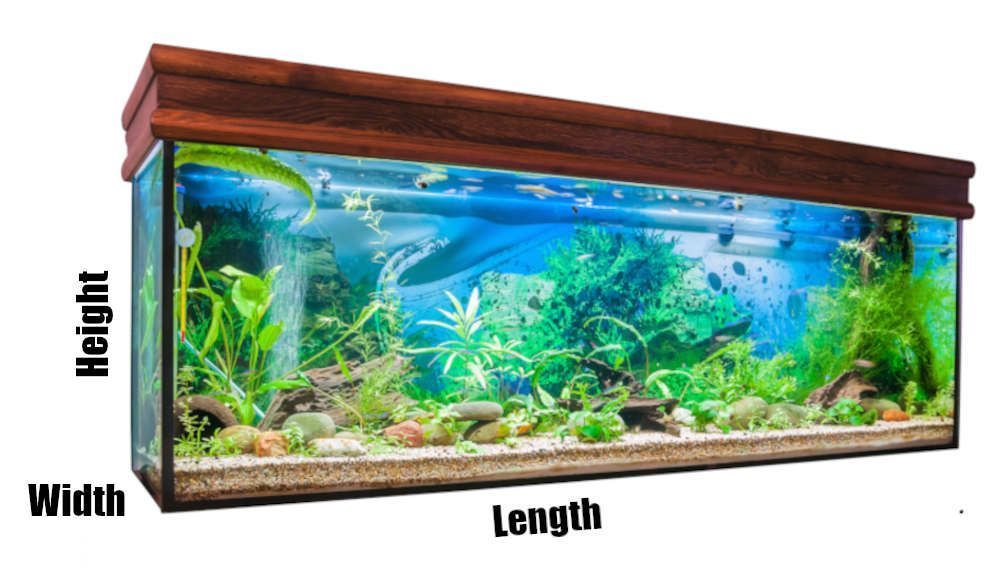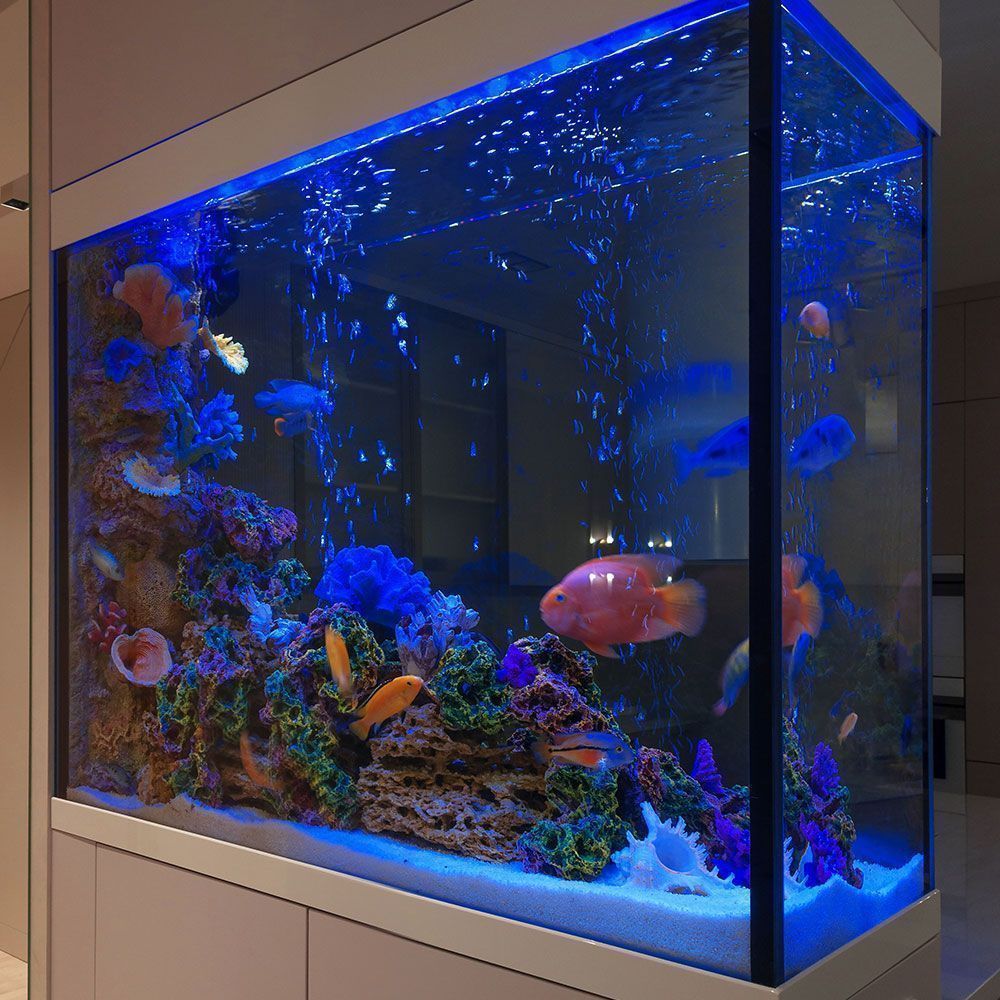
If you want to get your first aquarium or just add to your collection, you must first consider the range of aquarium sizes, dimensions and weights.
In the market, you can find various options for everything; right from aquarium body material to capacity or even shape.
But here, in this think-piece, we will discuss the standard ones: rectangular, standard capacity, glass aquariums.
In addition, we will also talk about Who is it for and Where to keep it.
Let’s get started!
Note: Weight calculation is done on following parameters:
- Tank Shape: Rectangular
- Tank Material: Glass
- Water Type: Freshwater
- Gravel Type: Seachem Flourite
- Water displacement is considered
- Tank accessories, rocks, plants, other décor, lid, base and fish weight are not considered
What are the Aquarium Sizes for Small Aquariums (Tank Capacity 2.5 to 15 gallons)?
| Fish Tank Size (in gallons) | Average Dimensions (in inches) L x W x H | Approx. Empty Weight (in lbs) | Approx. Water Weight (in lbs) | Approx. Gravel Weight (in lbs) | Approx. Total Weight (Empty + Gravel + Water) (in lbs) |
|---|---|---|---|---|---|
| 2.5 gallon | 12″ × 6″ × 8″ | 3 | 16.9 | 3.9 | 23.8 |
| 5 gallon | 16″ × 8″ × 10″ | 7 | 39.3 | 7 | 53.3 |
| 10 gallon Leader | 20″ × 10″ × 12″ | 11 | 75.9 | 10.9 | 97.8 |
| 15 gallon | 24″ × 12″ × 12″ | 21 | 109.2 | 15.7 | 145.9 |
| 15 gallon High | 20″ × 10″ × 18″ | 22 | 119.2 | 10.9 | 152.1 |
Who should have a small aquarium?
Many believe that small aquariums are suitable for beginner aquarists. However, that’s not the case at all because smaller tanks have unstable water chemistry. This is because the water can get polluted faster.
There is insufficient water to dilute the toxins and keep your fish healthy until the beginner knows basic cleaning rules. Due to low biofiltration capacity, you need good filtration and must have the bare minimum fish.
Moreover, there’s not enough space for your fish, which can even limit your pet fish’s growth.
So, these tanks are mainly suitable for pro-aquarists who know precisely how to manage aquatic animals and the environment.
Where to keep a small aquarium?
Small aquariums don’t need any particular infrastructure. They can be placed on any household furniture that’s in good condition.
What are the Sizes for Mid-sized Aquariums (Tank Capacity 15 to 40 gallons)?
| Fish Tank Size (in gallons) | Average Dimensions (in inches) L x W x H | Approx. Empty Weight (in lbs) | Approx. Water Weight (in lbs) | Approx. Gravel Weight (in lbs) | Approx. Total Weight (Empty + Gravel + Water) (in lbs) |
|---|---|---|---|---|---|
| 20 gallon High | 24″ × 12″ × 16″ | 25 | 150.9 | 10.9 | 186.8 |
| 20 gallon Long | 30″ × 12″ × 12″ | 25 | 136.6 | 19.6 | 181.2 |
| 25 gallon | 24″ × 12″ × 20″ | 32 | 192.5 | 10.9 | 235.4 |
| 29 gallon | 30″ × 12″ × 18″ | 40 | 214.6 | 19.6 | 274.2 |
| 30 gallon Breeder | 36″ × 18″ × 12″ | 48 | 245.8 | 35.3 | 329.1 |
| 40 gallon Breeder | 36″ × 18″ × 16″ | 58 | 339.5 | 35.3 | 432.8 |
| 40 gallon Long | 48″ × 12″ × 16″ | 55 | 301.7 | 31.4 | 388.1 |
Who Should have a medium sized aquarium?
Mid sized aquariums are easy to clean and maintain, making them an excellent choice for beginners. Though it’s said the bigger, the better, it entirely depends on the beginner aquarist’s budget.
They have ample space for fish to swim and to dilute toxins from excretion. Water chemistry changes are minimal and have enough space to house multiple fish.
Where to keep a medium sized aquarium?
Mid-sized aquariums need a specific stand to support their weight. It’s not safe to mount them on regular furniture.
What are the Sizes for Large Aquariums (Tank Capacity Greater than 40 gallons)?
| Fish Tank Size (in gallons) | Average Dimensions (in inches) L x W x H | Approx. Empty Weight (in lbs) | Approx. Water Weight (in lbs) | Approx. Gravel Weight (in lbs) | Approx. Total Weight (Empty + Gravel + Water) (in lbs) |
|---|---|---|---|---|---|
| 50 gallon | 36″ × 18″ × 19″ | 100 | 409.7 | 35.3 | 545 |
| 55 gallon | 48″ × 13″ × 21″ | 78 | 439.6 | 34 | 551.6 |
| 65 gallon | 36″ × 18″ × 24″ | 126 | 526.7 | 35.3 | 688 |
| 75 gallon | 48″ × 18″ × 21″ | 140 | 608.7 | 47 | 795.7 |
| 90 gallon | 48″ × 18″ × 24″ | 160 | 702.3 | 47 | 909.3 |
| 125 gallon | 72″ × 18″ × 21″ | 206 | 913 | 71 | 1190 |
| 150 gallon | 72″ × 18″ × 28″ | 338 | 1240.8 | 71 | 1649.8 |
| 180 gallon | 72″ × 24″ × 25″ | 430 | 1467.1 | 94 | 1991.1 |
| 225 gallon | 72″ × 27.5″ × 27.5″ | 358 | 1859.8 | 108 | 2325.8 |
Who should have a large aquarium?
Large size aquariums are mainly for experts who want to create a diverse aquarium. They need more attention for cleaning and maintenance.
Where to keep a large aquarium?
You definitely can’t put a large size aquarium on regular furniture. If you want to put them on the floor, you must get some sort of floor reinforcement. They require sturdy load-bearing infrastructure. You can also get adjustable floor supports.
Other than that, make sure that the floor is not bumpy. Check that the aquarium base is on the same level from front to back, sideways, and even diagonally. If the floor is uneven, invest in shims to level it.
How was the aquarium size calculation done?
If you want detailed insights into the calculations in the tables above, here you go.
How are the aquarium dimensions calculated?
The aquarium dimensions are averaged based on available sizes from top manufacturers like Aqueon, MarineLand, biOrb, etc.
What is the weight of the water in an aquarium?
1 gallon of freshwater weighs 8.3454 lbs, given that the temperature is 39.2 °F (4 °C) and its specific gravity is 1.000.
You must also fill the water only until ½-1 inch below the trim of your aquarium. This is so your fish has enough space to jump.
What is the formula to calculate the water weight of an aquarium?
Water Weight (lbs) = Tank Size (gallons) × 8.3454
Note: This is the maximum water needed. Actual water will be lesser as space from the trim, fish, equipment, décor and gravel is not considered in the above formula.
Example
If you have a 30-gallon Breeder aquarium, the maximum water weight will be 30 × 8.3454 = 250.36 lbs.
What is the difference between Freshwater and Saltwater weight?
At standard conditions, i.e., 39.2 °F temperature and 1.000 specific gravity, 1 gallon of freshwater weighs 8.3454 and 1 gallon of saltwater weighs 8.554. So, saltwater weighs more than freshwater.
So, again let’s take the example of a 30-gallon breeder:
Freshwater Weight: 30 × 8.3454 = 250.36 lbs
Saltwater Weight: 30 × 8.554 = 256.62 lbs
How to calculate the gravel weight for an aquarium?
Method 1
In our tables, we have calculated using Seachem Fluorite (density: 1005 kg/m3) for 1.5″ gravel depth.
The weight is calculated using online calculators.
All you need to do is input the aquarium length, width, gravel depth, and density. You will know exactly how much gravel you will need.
Method 2
Many suggest taking 1-1.5 lbs of gravel for every gallon of tank size.
Method 3
Some aquarists mention that you can find the gravel weight for your aquarium using the formula:
Gravel Weight = Tank Base Area (L × W) × 0.05 for 2 inches of gravel
For instance, the 30-gallon Breeder has dimensions of 36″ × 18″ × 12″. So, for 2″ of gravel, you need 36″ × 18″ × 0.05 = 32.4 lbs of gravel.
A word from FishInAquarium
In my experience as an aquarist, this was all about aquarium dimensions for you to know.
Besides, you must also pay attention to your expertise and the necessary support features to sustain your freshwater pets. If you are on a budget, note down all the required investments and spend wisely.
Now, if everything is clear, don’t forget to share it with your aquarium enthusiast friends. And if there’s any other doubt, don’t hesitate to drop us a mail with it!


